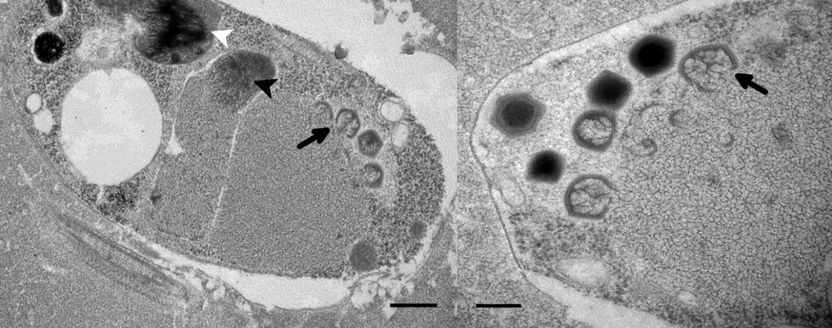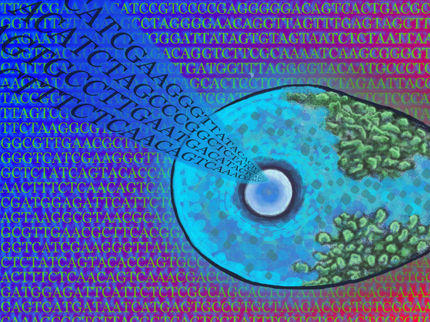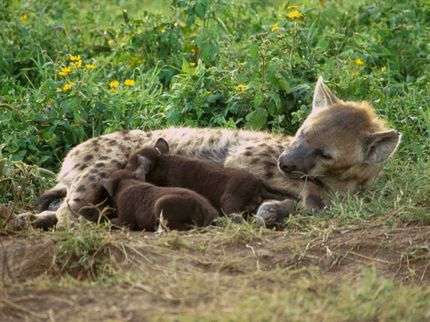Researchers capture first representative of most abundant giant viruses in the sea
Bodo saltans virus is one of the largest giant viruses ever isolated
Bodo saltans virus, the first isolated representative of the most abundant giant viruses in the sea, has been unveiled by researchers at the University of British Columbia.

This is a cell of Bodo saltan 24 hours after BsV infection (Left) and BsV virion assembly and maturation (Right).
Christoph Deeg, Curtis Suttle, University of British Columbia
The virus, whose genome weighs in at 1.39 million bases of DNA, is one of the largest giant viruses ever isolated, and the largest known to infect zooplankton.
"Bodo saltans virus is one of the few giants we've characterized that infects a common and ecologically important host," says University of British Columbia researcher Curtis Suttle. "It's representative of the most abundant giant viruses in the sea, yet until BsV was discovered, there was no way to investigate these viruses in the lab."
Because Bodo saltans virus (BsV) has to compete with a multitude of other viruses to infect its plentiful host-a microzooplankton called Bodo saltans-it comes armed to the hilt. It possesses an arsenal of toxins and DNA cutting enzymes, which likely interfere with other viruses trying to replicate inside the host.
During infection, BsV maneuvers towards the rear of the host cell and releases its viral genome. It appears that as BsV evolved it stole genetic machinery from the host to help in the infection process.
BsV doesn't carry transfer RNA (tRNA), part of the replication machinery all other giant viruses carry. It does, however, carry tRNA repair genes, making it likely that the virus uses the host's own tRNA during infection. Again, these genes appear to have been coopted by the virus directly from the host.
More than 10 per cent of BsV's genome encodes the same group of proteins that are likely involved in combating the host's antiviral system.
"These genes are actively being duplicated in an accordion-like mechanism in the periphery of the viral genome," says UBC graduate student Christoph Deeg, first author on the paper. "This suggests that the virus is engaged in an evolutionary arms race with its host, and could offer on explanation of how the genomes of giant viruses could reach their impressive complexity."
Giant viruses have much more DNA than typical viruses, enabling them to produce a multitude of proteins that allows them to replicate largely independently of their host.
Although researchers knew BsV-like viruses existed based on sequenced environmental DNA, only now has a representative virus been captured and studied in the lab. The Bodo saltans virus was isolated in samples from UBC's Nitobe Memorial Garden.
Original publication
Other news from the department science

Get the life science industry in your inbox
By submitting this form you agree that LUMITOS AG will send you the newsletter(s) selected above by email. Your data will not be passed on to third parties. Your data will be stored and processed in accordance with our data protection regulations. LUMITOS may contact you by email for the purpose of advertising or market and opinion surveys. You can revoke your consent at any time without giving reasons to LUMITOS AG, Ernst-Augustin-Str. 2, 12489 Berlin, Germany or by e-mail at revoke@lumitos.com with effect for the future. In addition, each email contains a link to unsubscribe from the corresponding newsletter.





















































